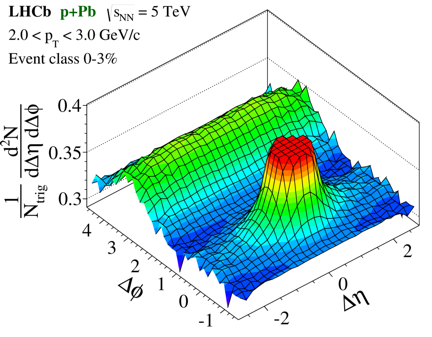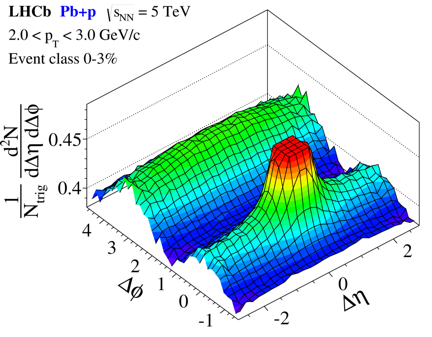The LHCb collaboration has submitted today a paper reporting the study of correlations in particle production in proton-lead ion collisions at the LHC. The plots (see below) showing the angular distribution of these correlations exhibit features similar to a “ridge” in a mountain landscape. Therefore physicists name this kind of analysis a study of a “ridge effect”.
Two sets of data were taken: proton-lead and lead-proton, where in the second case the direction of the proton and lead ion beams were reversed. This allowed the LHCb detector, recording the particles only on one side of the interaction point, to make measurements in the case of the proton beam pointing towards the LHCb detector as well as in the opposite case of the lead beam pointing to it.
The idea of the analysis is simple. LHCb physicists plotted differences Δ between production angle of particle pairs both in angle θ along the direction of incoming proton or lead beams, and in angle φ around this direction. The difference in angle θ is plotted as the difference of a related variable, pseudo-rapidity η, where η=-ln(tan(θ/2)). In this way the plot bin sizes closer to the beam direction are expanded.
The Δη-Δφ distributions show three different features. The high peak structure near Δη=Δφ =0 is caused by a clustering of particles, forming a jet-like structure. This peak has a width of about Δη=1 and is truncated in the images in order to allow a better visibility of other features. Since momentum must be conserved, another structure is observed on the opposite side at Δφ=π. The distribution in Δη is, however, broad and is referred to as the “away-side ridge”.
The third structure, the “near-side ridge”, is the most interesting and its study is the main subject of today’s paper. It is seen on both sides of the high peak at Δη=Δφ =0 in the images above. Only properties of 3% of events, characterized by the highest “activity”, are contributing to the shown distributions. A very precise Vertex Locator detector (VELO), surrounding the proton-lead interaction region, is used to measure the number of produced particles in the collision and to define the activity of the event. The two plots above show that the near-side ridge is more pronounced in the highest activity events (event class 0-3%) when the lead (Pb) beam is pointing towards LHCb detector (Pb+p) than in the opposite case.
The numbers of particles observed in the LHCb detector are not identical in these two cases. It is higher in the case of lead ions pointing towards the LHCb detector (Pb+p) than in the opposite case (p+Pb). Here LHCb physicists have introduced an original idea to the analysis and also made an important discovery. By comparing events with similar numbers of particles observed in the acceptance of LHCb detector (similar absolute activity), LHCb physicists found out that the sizes of the near-side ridge effect in the direction of the lead (Pb+p) and proton (p+Pb) beams are in fact compatible.
The ridge-like near side effects were studied in heavy ion collision experiments in order to investigate a possible manifestation of a quark-gluon plasma formation, see 10 May 2013 news for an introduction. The observation of the similar near-side ridge correlations in proton-proton collisions by the CMS collaboration and in proton-lead collisions by the LHC experiments came as surprise since the formation of quark-gluon plasma was a priori not expected in these collisions. The interpretation of today’s LHCb results obtained in the forward acceptance is clearly an interesting challenge for theorists.
LHCb, the world’s first dedicated b-physics experiment at a hadron collider, has obtained not only excellent heavy flavour results, but in addition the quality of the LHCb detector and its unique forward geometry allows it to obtain also important results in other fields, like electroweak physics or heavy ions physics, as reported today. The LHCb contribution to the heavy-ion physics will increase significantly in the near future since presently, for the first time, the collaboration is taking also lead-lead collision data.
Read more in the LHCb publication.


